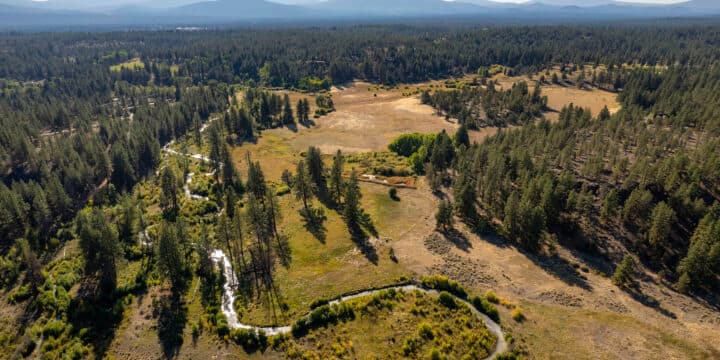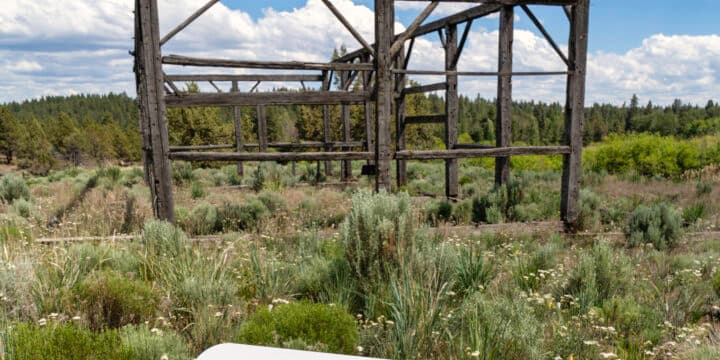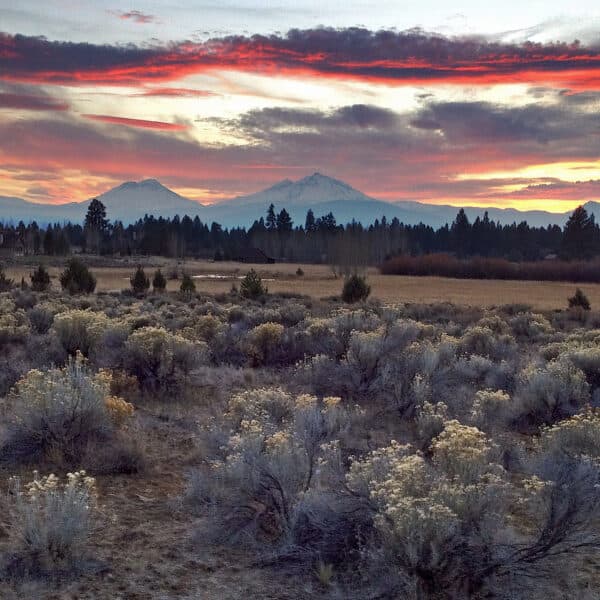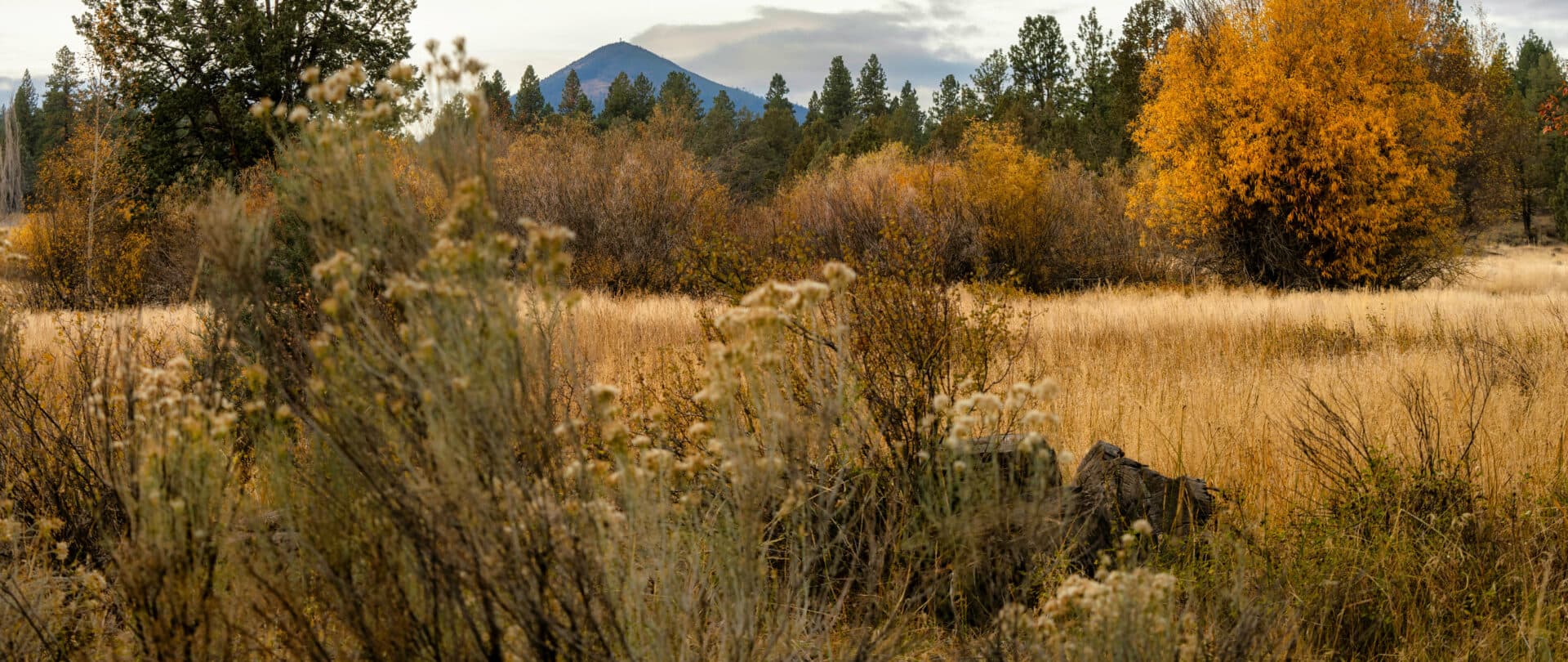Restoring Land
Camp Polk Meadow Preserve protect miles of critical fish habitat and is home to Deschutes County’s oldest historical Euro-American structure.
BY Meghan Robins
Located northeast of the town of Sisters, Camp Polk Meadow Preserve is a 151-acre nature preserve owned and managed by the nonprofit Deschutes Land Trust. Open year-round during daylight hours only, the preserve is divided into two parts: the publicly accessible Hindman Springs Area with a flat, half-mile, gravel trail; and the large, protected meadow areas that are closed to the public unless on a guided tour.
Amenities in the Hindman Springs Area are limited, so plan your trip accordingly by visiting deschuteslandtrust.org before heading out. Accessibility features have been added recently to improve the experience for all visitors. These improvements include resurfacing and grading the parking lot for easier access to trails, adding a new accessible portable toilet, resurfacing trails with more compactable gravel mix that is easier for wheeled users to navigate, widening and improving trail transitions in certain areas and repairing the wildlife-friendly perimeter fence. Note that roads and the parking lot are not plowed during the winter and dogs are never allowed at Camp Polk Meadow Preserve.
Like many watershed areas in Central Oregon, Camp Polk Meadow Preserve has a rich and challenging history. Since time immemorial, the area now called Central Oregon has been the traditional lands of the Wasco (Wasq’u) and Warm Springs (Tana’ma) Peoples, with crossover from many neighboring nations including the Wasco (Chinookan), Klamath, Molalla, Tenino, Tygh, Wyam, John Day (Sahaptin) and Northern Paiute (Numu) Peoples who traveled into the area for trade, harvesting seasons and when following game. The Wasco, Warm Springs and Northern Paiute Peoples make up the Confederated Tribes of Warm Springs.

Archeologists have found evidence that Indigenous Peoples have been living in Central Oregon since at least 12,000 years ago. Today, members of the Confederated Tribes of Warm Springs maintain their rights to fish, hunt and harvest at traditional locations like Camp Polk Meadow Preserve. They continue to use extensive knowledge from generations of observation, understanding and active management to maintain the important innerworkings of both wet and dry meadow landscapes. Landowner Deschutes Land Trust and the Confederated Tribes of Warm Springs have formed a critical partnership in the continual management and restoration of Land Trust preserves throughout Central Oregon.
In the early 1800s, Euro-American trappers, missionaries, gold-seekers and explorers like John Frémont, whose party camped near Camp Polk in the early 1840s, were encouraged by the U.S. government to travel to and settle Indigenous Nations’ territories throughout the American West illegally and without express permission.
In 1855, the U.S. Army-led Pacific Railroad Survey team stayed near Camp Polk Meadows while searching for possible railroad routes to connect the Sacramento Valley to the Transcontinental Railroad. That same year under the Treaty of 1855, multiple Indigenous Nations ceded nearly ten million acres of their ancestral lands throughout Oregon Territory, trading it for 640,000 acres pinched between two smaller tributaries with poorer soil on what is now the Warm Spring Reservation. Before the ink was dry, land was offered by the U.S. government to any white male willing to work it. Between the 1830s and 1870s nearly half a million squatters descended upon Wasco and Warm Springs territories via the Oregon Trail, purchasing land via various U.S. government legislation acts.

Camp Polk was officially given its name in 1865 when, for one year only, it served as an army outpost designed to protect the Santiam Wagon Road from marauders and to ease relations between Indigenous People and the new homesteaders. The Santiam Wagon Road (now listed on the National Register of Historic Places) was a critical trade route connecting commerce, livestock, gold fields and travelers from the Willamette Valley to the eastern pasture lands of Central Oregon. Many of the original 40+ soldiers stationed at Camp Polk were from Polk County in the Willamette Valley. They built eight log structures before abandoning it in 1866 due to low need for protection. Today, the historic Santiam Wagon Road can be visited at Camp Polk Meadow Preserve, Indian Ford Meadow Preserve and Whychus Canyon Preserve. Visit deschuteslandtrust.org/wagonroad for more information.
After Camp Polk was abandoned, a Pennsylvania-born man named Samuel Hindman purchased 160 adjacent acres in 1868 from the Willamette Valley and Cascade Mountain Wagon Road Company. Soon after that he built a home, barn and Hindman Station, offering a mercantile, post office and open pastures for travelers to rest, resupply and feed their horses and cattle. The Hindman Barn, which was built around 1870, is still partly standing and is considered one of the oldest Euro-American structures in Deschutes County. A new spur trail was recently built at the preserve leading to the Hindman Barn that allows visitors access to this historical site.
For over 70 years, until 1940, members of the Hindman family continued to live at Camp Polk. Deschutes Land Trust established Camp Polk Meadow in 2000 as a preserve, which includes the protection of nearly two miles of wetlands and a critical habitat for steelhead trout and Chinook salmon.
In 2012, the Whychus Creek restoration project successfully rerouted and returned the river to its natural state, which flows through the preserve. Previously, Whychus Creek had been narrowed and rerouted by dams and farmers and typically ran dry through the town of Sisters by mid-summer. Today, great efforts are being made in partnership with the Confederated Tribes of Warm Springs and others to restore salmon and steelhead to Central Oregon’s rivers and streams.
Before you visit Camp Polk Meadow Preserve or any other Deschutes Land Trust areas, plan your trip accordingly. Check for timely details like seasonal closures and available guided tours. Central Oregon has a multitude of parks, land trusts and nature preserves that welcome visitors and residents alike to engage more deeply with the area’s natural and human history.
You May Also Like

Culture
Preserving Nature
Since 1995, Deschutes Land Trust has worked with private landowners to permanently protect scenic land and waterways, starting with the Indian Ford Meadow Preserve.

Art + Design



